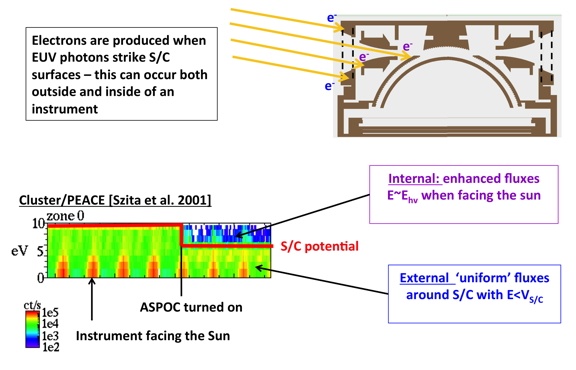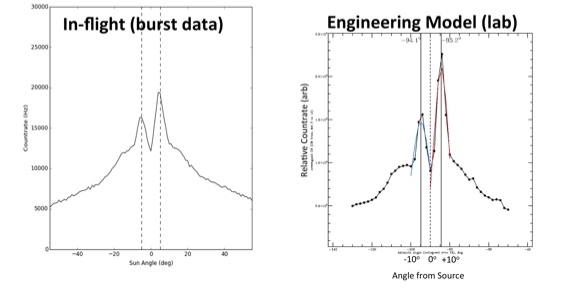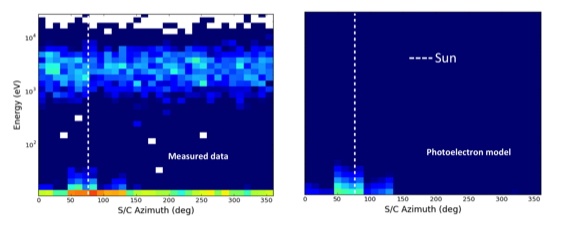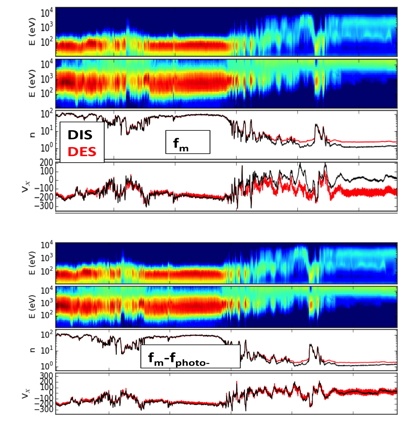...
- Spacecraft photoelectrons are measured by DES at energies below the spacecraft potential. The spacecraft potential is measured and reported by the electric field double probe. The potential is plasma and spin-phase dependent and approximately uniform across the spacecraft. When the spacecraft controller (ASPOC) is activated, the spacecraft potential decreases as do the energies of spacecraft photoelectrons.
- Secondary electrons produced inside the instrument are measured at low energies independent of ambient plasma or spacecraft potential. The fluxes of these secondary electrons maximize when a given instrument is facing the Sun and are present independent of ASPOC operation.
| Figure 1. (top right) Illustration of photoelectron production in DES. (bottom left) Cluster/PEACE data demonstrate the sensitivity of each population to spacecraft potential (Szita et al. 2001, Cluster PEACE observations of electrons of spacecraft origin, Ann. Geophys.) |
Correcting for Spacecraft Photoelectrons
...
There are subtle changes in the photoelectron fluxes as a function of spacecraft spinphase because the EUV from the Sun has different incident angles to each analyzer. A comparison of the derived photoelectron model with spacecraft data as well as with laboratory testing is shown below in Figure 2. There is a double peak in each analyzer with respect to the angle of incidence of EUV photons due to the large deflection plates used that readily reflect light further into the instrument. The signal from the photoelectrons shown in Figure 3 is measureable up to ~100eV, though is most prominent at the lowest energies (i.e., <50eV).
| Figure 2. (left) Burst data collected on-orbit and (right) laboratory data binned by Sun-instrument angle. Two peaks are observed that correspond to light reflection from DES deflector plates. The asymmetry is caused by asymmetric paths of light into the DES top-hat from the deflectors. |
Figure 3. (left) Measured data during MMS commissioning of photoelectrons. (right) Model of internally generated photoelectrons. Data are uncorrected, pixel averaged, and ordered by spacecraft azimuth and energy. The vertical white line denotes the anti-sunward direction. In the measured data, spacecraft photoelectrons are observed in the low energy channels and hot plasma sheet electrons are observed at ~2keV. The internally generated photoelectrons show multi-peaked structure and spin-phase dependence due to the evolving angles of incidence of the sunlight on each of the 8 DES sensors. |
All observatories exhibit similar behavior such that the same angular structure of the photoelectron model is used for all spacecraft. There is a single tuning factor for each that controls the effective density of the photoelectrons. This tuning factor varies both with time and with spacecraft. The tuning factor was selected for each observatory as a function of time to give Vi,x ~ Ve,x inside the magnetosphere. The tuning factors range from ~0.5-1 and are likely accurate to ±0. 1. These factors are included as global attributes in DES moment CDF files as ‘photo_scale_factor.’ We will refer to this number as nphoto, as it represents the approximate number density of the internally generated photoelectron population.
...
As shown below for an example magnetopause crossing on August 15, 2015, uncorrected data show a 200km/s antisunward flow inside the magnetosphere. Once corrected for photoelectrons, Vxi ~Vxe ~ 0 km/s inside the magnetosphere. After correction, the electron and ion densities inside the magnetosphere still differ by ~1 cm-3. Populations of electrons and ions outside the FPI energy ranges (10eV-30keV) but traveling at similar bulk velocities to the measured particles may account for this discrepancy. Care should always be taken before interpreting FPI moments from both ion and electrons inside the magnetosphere.
Figure 4. (top panels) Magnetopause crossing data uncorrected for internally generated photoelectrons. An anti-sunward offset of Vx = -200 km/s appears due to the inclusion of photoelectrons in the moment integrals. (bottom panels) The same magnetopause crossing corrected for internally generated photoelectrons using f – nphotofphoto. After correction, Vx,i ~ Vx,e. |
| Info |
|---|
The photoelectron model is available in the “/data/models/fpi” subdirectory at the MMS Science Data Center (https://lasp.colorado.edu/mms/sdc/public/). Author for this section: Dan Gershman , , , , , , … (2017). Spacecraft and instrument photoelectrons measured by the dual electron spectrometers on MMS. Journal of Geophysical Research: Space Physics, 122, 11,548–11,558. https://doi.org/10.1002/2017JA024518 |
...



